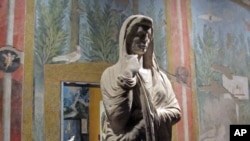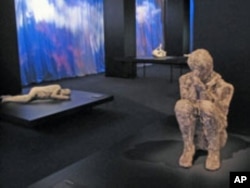Two thousand years ago, on the west coast of what is now Italy, the Roman seaport of Pompeii was thriving. Twenty thousand people farmed and traded in the shadow of Mount Vesuvius. They made beautiful objects, worshipped their gods, and enjoyed wine from grapes grown in the fertile volcanic soil. But on a single day in 79 AD, all of that came to an end.
An exhibit at Discovery Times Square in New York presents more than 250 objects found at Pompeii and the nearby resort town of Herculaneum. They include mosaics, sculptures, frescoes, glass and pottery as well as fishhooks, a gladiator’s helmet, and women’s cosmetic items. There is even a loaf of bread that looks freshly-baked, although it’s hard as stone. The perfect preservation of these items seems unlikely, to say the least.
A big-screen animation tells the story. On August 24, 79 AD, Pompeiians awoke to what seemed like a normal day. But Mount Vesuvius was about to erupt. By 1 p.m., volcanic smoke was spewing into the sky, and the earth was shaking. Late that afternoon, toxic fumes, lethal heat and flames filled the air. Within 24 hours, the city was buried under five meters of dust and ash. Rain turned it to cement, capturing forever Pompeii’s last moments.
"It was an incredibly destructive event that ironically preserved this slice of life we would not have known about otherwise," said Kristin Romey, Discovery’s curatorial consultant. "It resonates in the sense that there’s a human element to the ancient world that you don’t usually get when you go to a museum and all you see are temples and statues."
Ancient Pompeii had a lively street life, with restaurants, wine bars, bakeries, food shops and at least 40 houses of prostitution that catered to various classes, from the wealthy to slaves. The room of one brothel is reproduced in the show, tucked away where young visitors are less likely to come upon it.
Pompeiians enjoyed erotic humor and art - sculptures and frescoes - that would be considered pornographic in most modern societies. Judith Harris, author of "Pompeii Awakened," said Pompeii was a pleasure-loving mercantile town, at the mouth of a river by the sea, somewhat like New Orleans today.
"Further up the coast line, there were resorts and there were very fancy, elaborate homes," she said. "Pompeii inhabitants were well-to-do owners of townhouses, they were traders, they were ship captains, they were bankers."
Although most ordinary Pompeiians lived in multi-family buildings, the wealthy had fine townhouses, some with running water and hot tubs. Most were two-story, and all were decorated.
"All the fancy houses had frescoes and mosaics," Harris said. "In the servants’ quarters, these would have been much more simple. They would just do paintings of reeds, for example. But every surface was painted."
The show’s vibrant color ends abruptly in a darkened room with ghostly white-plaster casts of people and animals who died that August day. They were cast from imprints left by bodies that had decayed in the hardened ash. Kristin Romey said only about 1,100 such relics were found, from a town of at least 20,000.
"Slaves that had been chained, dogs that were unable to flee," said Romney. "But that’s one of the big questions we have: who got out, and why did others stay behind?"
Today, more than 3 million people live near Mount Vesuvius, still considered one of the world’s most dangerous volcanoes. The Discovery show includes a newsreel showing its most recent eruption, in 1944. That was a shadow of the volcano that engulfed Pompeii 2,000 years ago. The show, which is on view until September, was curated by the Italian government authority responsible for Pompeii, and organized by Running Subway Productions, a New York entertainment production company. Some of the proceeds will go to preserve the site.








